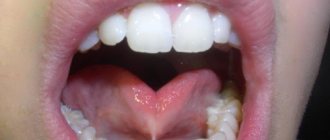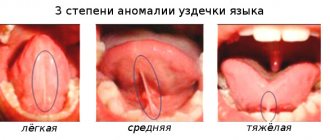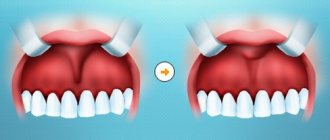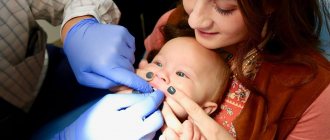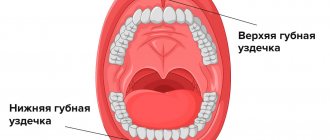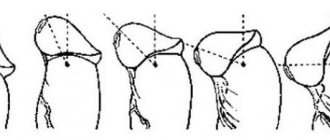Unfortunately, even parents who are not privy to medical subtleties are familiar with the opinion that a short frenulum of the tongue in a child is the cause of speech therapy problems.
Why "Unfortunately"? Because it is ignorance of the material that leads to a clear decision - the bridle needs to be trimmed! Do you remember in the film “Pokrovsky Gate” the characteristic female surgeon with her famous phrase “Cut!.. without waiting for peritonitis”? So the same thing often happens to the poor bridle. However, as experience shows, there is not always only one way out. Not every case of the so-called “short frenulum” requires radical measures.
Tongue frenulum cutting - what is it?
Plastic surgery of the lingual frenulum can be performed at different ages, but it is mainly performed on newborn children, since disruption of the formation of the mucosal fold under the tongue causes a number of functional disorders.
The procedure for trimming the frenulum of the tongue is a low-traumatic surgical procedure performed by a dentist. The frenulum of the tongue is a fold of the oral mucosa that stretches in the shape of an arc from the central point of the tongue to the middle of the lower dentition at the base of the gums. The main function of the frenulum is to attach the tongue to the lower part of the mouth.
If there are deviations in the location or length of the fold, the movement of the tongue will be impaired, resulting in incomplete functionality. The purpose of the operation is to increase the length or correct the position of the frenulum.
Consequences of frenulum anomaly
Hypotrophy due to impaired sucking, poor weight gain in infants.
Malocclusion, the first signs of which during the period of temporary occlusion is the rotation of the central lower incisors to the lingual side.
Impaired development of the lower jaw, as a result, the formation of a distal bite.
Local gingivitis, periodontitis up to exposure of the roots of the teeth in the area of the lower jaw incisors.
Violation of the pronunciation of sounds that require raising the tongue upward: “sh”, “zh”, “sch”.
Impaired language development due to asymmetrical growth. Low mobility of the tongue impairs the articulation of some sounds. Violation of diction (clarity, intelligibility of pronunciation).
Indications for the procedure
For newborn children, cutting the frenulum of the tongue is recommended quite often. A pediatrician or dentist can identify the pathology. In most cases, disorders are detected already in the first months of a child’s life. At the same time, the doctor always takes into account the individual characteristics of the structure and position of the mucous fold.
If we are talking about a newborn baby, then plastic surgery is prescribed in the case of obvious pathology in the formation of the frenulum, or difficulties with breastfeeding. The baby may have difficulty latching on to the nipple or pacifier and difficulty sucking on the breast or bottle.
Untimely plastic surgery may subsequently lead to difficulties with chewing food, bite formation, and diction problems. In older age, recommendations for surgical treatment can be given by a speech therapist or orthodontist.
Symptoms
When crying, the tip of the baby's tongue bifurcates in the shape of a stylized heart.
The baby cannot stick his tongue out of his mouth. To test this reflex, you can run your finger over the baby's lips. Normally, the baby sticks his tongue out quite far, moving it around his lips in search of mother's milk.
Breastfeeding takes a lot of time, the baby is capricious, nervous, and clicking sounds are heard when sucking.
The baby is not gaining weight well.
A child with a short frenulum cannot reach the palate with his tongue.
There is a noticeable disturbance in the pronunciation of certain sounds during speech formation.
With a short frenulum (less than 1.5 cm), if it is attached to the soft tissues of the floor of the mouth, functional disorders do not always occur. These include difficulty sucking during breastfeeding and disturbances in sound pronunciation during the formation of phrasal speech.
Contraindications
Tongue frenuloplasty in newborns does not involve major surgical intervention, so the operation is considered safe. In addition, the procedure is painless and does not require anesthesia. However, given that after cutting a short fold of mucosa, a small wound still forms, there are temporary restrictions on manipulation related to the child’s health condition.
Temporary contraindications:
- inflammatory diseases;
- infectious diseases;
- immunodeficiency pathologies;
- acute respiratory viral or bacterial infections.
If there are contraindications for health reasons, it is advisable to postpone the operation until complete recovery.
Circumcision and removal (excision) of the frenulum
Surgical intervention to circumcise the frenulum of the foreskin is not considered mandatory if there are no alarming symptoms. But most experts advise carrying out this procedure as a preventive measure.
Carrying out the procedure
- in circumcision of the foreskin followed by frenuloplasty, mainly for phimosis;
- in excision of the frenulum followed by plastic surgery to restore the anatomical length;
- in excision of the frenulum of the foreskin.
Circumcision of the foreskin and frenulum together is carried out for medical reasons or for religious reasons. If circumcision is performed for medical reasons, the most common reason for the procedure is phimosis - this is a pathological narrowing of the foreskin, which makes it difficult to expose the head of the penis. Phimosis can also be either congenital or acquired as a result of diseases or injuries.
In its presence, the patient may experience difficulties during sexual intercourse, urination, and also very often suffers from swelling and inflammatory processes.
The main danger of this disease is the formation of cracks in the frenulum and foreskin, which can turn into scars and welts after healing. In some cases, the tissues of the glans penis adhere to the foreskin, which can cause pain when trying to open the glans. During the operation, the foreskin and frenulum are excised, which can lead to the return of anatomical functions. Also, phimosis can be operated on with subsequent preservation of part of the foreskin. Circumcision can also be performed simultaneously with frenuloplasty.
Indications for frenulum circumcision
The operation of circumcision of the foreskin and frenulum, in contrast to frenulotomy, is performed not only in adults, but also in children and infancy, if indicated.
Operation techniques
At the moment, circumcision of the frenulum of the foreskin can be carried out using a standard method using a scalpel, as well as using laser technologies.
The operation is carried out over thirty to forty minutes. The likelihood of complications is minimal, and in most cases there are none at all.
During the recovery period, it is very important not to violate hygiene, and also to follow all established instructions and doctor’s advice. The scar after surgery can heal very quickly and becomes almost invisible. Stitches are usually applied using special self-absorbable threads; they can disappear after ten days. After healing and rehabilitation, it will take fourteen to twenty-one days, after which you can continue to be sexually active.
Features of the procedure
Plastic surgery of the frenulum of the tongue involves cutting it with a scalpel or surgical scissors. After cutting the fold of the mucous membrane in a newborn, the tissue immediately stretches and lengthens after healing. When the operation is performed at the age of 3–5 years, the process of stretching the frenulum is more complex. To increase the length of the fold and prevent the formation of scars, the child will need to perform special exercises.
In Martinka dentistry, plastic surgery of the frenulum of the tongue and lip is performed not only by the classical, but also by the modern method using a laser. The use of laser equipment eliminates the risk of infection and bleeding. The laser has an antiseptic effect and instantly seals the vessels; moreover, during the operation there is no contact of the instrument with the tissues of the oral cavity. Laser surgery involves contraindications and is only allowed for children over 1 year of age.
For newborn children, tongue frenuloplasty can be performed without anesthesia. In children from 3 months of age, the folds of the mucous membrane thicken, which suggests discomfort and minor pain during the operation, so cutting the frenulum is done with local anesthesia. Sedation is used only in extreme cases, if the child has complex illnesses or increased anxiety.
At what age should this be done?
If we talk about a non-surgical method for stretching the hyoid ligament, it is effective up to the age of 5 years with constant and regular training.
The operation as a whole has no restrictions and no special recommendations about at what age it should be done. Each stage of development of a child’s body requires one of several ways to correct this ligament. Thus, newborns undergo a dissection of the frenulum, and already at the age of 2–3 years, when the tissue of the ligament becomes denser, the need for sutures arises. Sometimes it may be necessary to remove some of the ligament tissue. Laser surgery has no age restrictions.
To avoid the formation of malocclusion and displacement of the dentition, it is advisable to correct the frenulum before the molars appear.
Stages of the procedure
Trimming a short frenulum, despite the lack of complexity of the procedure, should be performed by a qualified specialist and in a medical facility. Patients do not require hospitalization. The operation takes no more than 10 minutes. Immediately after completion of the plastic surgery, the child is sent home. It is not recommended to feed the baby in the first two hours. Young children are allowed to drink water.
Stages of plastic surgery of the frenulum of the tongue.
- Preparation. The doctor asks parents for complaints, performs an examination and, if necessary, gives recommendations on preparation for the procedure.
- Operation. Administration of anesthesia, antiseptic treatment of the oral cavity, trimming of the frenulum.
In newborns, the integrity of the mucous membrane is restored in 1–3 days. The child may be restless on the first day. Difficulties with feeding cannot be ruled out, but already on the second day, babies begin to correctly take the breast or bottle nipple, which caused difficulties previously. Parents are advised to give the baby water after each feeding to avoid the accumulation of formula or milk in the mouth and the subsequent development of infection. Also, the mother must maintain breast hygiene and sterilize bottles.
Short frenulum of the tongue
The frenulum of the tongue (frenulum linguae) is a fold of the oral mucosa that runs along the midline and connects the floor of the mouth with the lower surface of the tongue (encyclopedic dictionary of medical terms, 1984). Sometimes the terms lingual ligament and sublingual ligament are used. The function of the tongue frenulum is to fix the tongue to the soft tissues of the oral cavity, prevent tongue retraction and glossoptosis, especially during the neonatal period. Normally, the frenulum of the tongue comes from the middle of the lower surface of the tongue and is attached to the mucous membrane of the floor of the mouth in the area of the excretory ducts of the sublingual salivary glands (Fig. 1). By the age of 18 months, the free tip of a child's tongue should reach at least 16 millimeters. Measuring the absolute dimensions of the lingual frenulum has not found widespread use in clinical practice. It is believed that the length of the frenulum of the tongue during the period of mixed dentition should be at least 21 mm, and the width no more than 4 mm.
Fig.1. Variants of attachment of the frenulum of the tongue are normal. The permissible place of attachment to the lower surface of the tongue is highlighted in black. Green – to the mucous membrane of the floor of the mouth.
A short frenulum of the tongue is one of the most common MINOR DEVELOPMENTAL ANOMALIES of the oral cavity. This pathology is sometimes called ankyloglossia. Ankyloglossia (ankyloglossia) is a developmental anomaly: shortening of the frenulum of the tongue from Ankilos - (Greek, crooked, curved) a component of complex words, meaning 1) “curvature”, hook-shaped 2) “stiffness or fusion of parts” and Glossa - (Greek. ) – language (encyclopedic dictionary of medical terms 1982). This term is not widely used in the domestic medical literature and clinical practice, although it reflects some clinical manifestations (curvature of the tongue and its stiffness).
According to various authors, a short frenulum of the tongue is diagnosed in 2.3-19% of subjects, and in boys, a short frenulum of the tongue occurs significantly more often than in girls with a frequency of 1: 300 in newborns. Such a significant scatter of statistical data indicates the vagueness of the applied diagnostic criteria and different principles of classification. The length of the short frenulum of the tongue is no more than 1.7 cm, but this does not always cause dysfunction of the tongue, especially if the anatomical frenulum is located correctly.
Etiologically, a short frenulum of the tongue is often caused by a hereditary predisposition. There is also information about the significance of intrauterine trauma to the frenulum of the tongue (from thumb sucking).
Clinical manifestations of a short frenulum of the tongue.
During the period of toothless oral cavity (up to 6 months), with the jaws closed, the tongue occupies the entire oral cavity, its edges extend beyond the gums. Normally, in the anterior part of the oral cavity there is a gap between the gingival ridges of approximately 3 mm. the tip of the tongue is located between them. The mobility of the tongue root is small and increases to normal by 3-6 months. During this period, the child’s sucking and swallowing is infantile , i.e. When swallowing, the tongue pushes away from closed lips, and there is visible tension in the facial muscles of the perioral area. Subsequently, the infantile type of sucking and swallowing is replaced by a somatic one , when the tongue is pushed away from the palatal surface of the teeth and the anterior surface of the hard palate. During the formation of a temporary bite, the tongue is normally located behind the teeth.
With a short frenulum, when the tongue is tense, its tip is forked in the form of a stylized heart, the edges of the tongue are raised (Fig. 2).
Fig.2. Short frenulum of the tongue. The length of the frenulum is 1.3 cm - 8 mm less than the norm. The tip of the tongue is forked.
The child cannot lick the upper and lower lips. When you try to stick it out, the back of the tongue rises, the tongue becomes curved, “humpbacked”. The short frenulum starts from the tip of the tongue or in its anterior third and is attached to the mucous membrane of the alveolar process of the mandible (Fig. 3). There are variants of ankyloglossi, when the frenulum is attached in the area of the excretory ducts of the sublingual salivary glands, and then, changing direction, is woven into the mucous membrane of the alveolar process in the form of a “crow’s foot” (Fig. 4).
Even with a short frenulum (less than 1.5 cm), if it is attached to the soft tissues of the floor of the mouth, functional disorders do not always occur - difficulty sucking during breastfeeding and disturbances in sound pronunciation during the formation of phrasal speech.
Fig.3. Options for attaching the frenulum of the tongue in ankyloglossia. The place where the frenulum attaches to the tip of the tongue and its anterior third is highlighted in black. Green – to the mucous membrane of the alveolar process and the transitional fold of the mucous membrane of the floor of the mouth.
Rice. 4. The short frenulum of the tongue is attached to the mucous membrane of the alveolar process in a fan-shaped manner - in the form of a “crow’s foot”. The back of the tongue bends when trying to lift it.
As a result of the stiffness of the tongue caused by a short frenulum, malocclusions can form, the first signs of which during the period of temporary occlusion are the rotation of the central lower incisors to the lingual side.
Functions of the language.
The functions of the tongue can be divided into two large groups: sensory and motor (mechanical). In some animal species, the tongue plays a significant role in thermoregulation.
Sensitive functions include taste, temperature, tactile, and pain. Pathology of the frenulum of the tongue does not affect sensory functions.
The motor functions of the tongue, in turn, can be divided into nutritional, speech and aesthetic.
The tongue, as an organ of the digestive system, is involved in providing nutritional functions - chewing, swallowing, sucking, licking, lapping, cleansing the mouth (spitting). A short frenulum of the tongue can interfere with the implementation of these mechanical functions, mainly sucking. Licking and lapping are rudimentary nutritional functions for humans.
The tongue is one of the main articulators providing the function of speech. Speech is unique to humans; its physiological basis is the second signaling system. Pathology of the frenulum of the tongue does not affect the formation of speech in general, but only the formation of some sounds.
The aesthetic meaning of language plays a significant role in the socialization of an individual. Various “teases”, showing the tongue, are characteristic of people of different ages, social status, races and nationalities.
Sucking.
Currently, the importance of the implementation of the sucking instinct during the newborn period and breastfeeding (natural) feeding is beyond doubt - “...it is in natural feeding that real ways and opportunities are laid for achieving biological perfection within the framework of one’s own species, the implementation and adjustment of the genetic fund, species-specific forms of initial socialization... The work of the muscular sucking apparatus when feeding a child determines the occurrence of efforts and tensions that most adequately regulate the anatomical formation of the dentoalveolar system, the cerebral skull, as well as the sound reproduction apparatus" (Vorontsov I.M., Fateeva E.M. Khazenson L.B., 1993 ).
Sucking is an innate unconditioned reflex (instinct) that is formed during intrauterine development. In an 18-week fetus, sucking movements of the lips are observed, at 21-22 weeks - spontaneous sucking, at 24 weeks - searching and sucking reactions. The sucking reflex is one of the most stable, the absence or significant suppression of which is extremely rare. Thus, the sucking reflex is observed even in mammals with aencephaly. Excitation from the receptors of the lips and tongue is transmitted through the centripetal nerves (trigeminal) to the center of sucking, located in the bulbar region, the centrifugal nerves (trigeminal, facial, hypoglossal) transmit excitation to the tongue, chewing and facial muscles that ensure the act of sucking. In the first weeks of a child's life, sucking is an unconditioned reflex, which is gradually replaced by a mixed and then a conditioned reflex.
An unrealized sucking instinct often leads to various types of obsessive-compulsive neuroses, sometimes manifesting throughout life.
When breastfeeding, the act of sucking is divided into two stages - suction and compression. The child clasps the areola of the breast with his lips and gums, more from below than from above; the nipple is at the level of the soft palate and does not participate in sucking. At the same time, the velum palatine descends. The tongue, taking the form of a groove descends together with the lower jaw downwards and backwards, a muscle wave is formed, passing from the front to the middle part of the tongue, thus creating a negative pressure in the oral cavity - 2-4 mm. mercury column. Tightness is also ensured by transverse folds on the mucous membrane of the lips and palate, and Bisha's fatty lumps in the cheeks. Then the lower jaw rises and the alveolar arches compress the chest, allowing the sphincters of the milk ducts to relax. Thus, alternating negative pressure during suction and positive pressure during compression ensures a dosed and rhythmic flow of milk. The tongue does not have an exclusively independent role in sucking ; its movements are strictly coordinated with the movements of the lower jaw, chewing and facial muscles.
Bottle sucking is different from breastfeeding. When sucking a bottle, the child makes mainly retracting movements, which are provided by the muscles of the cheeks and forward movements of the tongue. In this case, the flow of milk is continuous.
Difficulties in feeding during the newborn period.
Contraindications to breastfeeding.
The mother has: especially dangerous infections (smallpox, hemorrhagic fevers, etc.), open form of tuberculosis, syphilis, decompensation of chronic diseases of internal organs, malignant neoplasms, acute mental illnesses, treatment with certain medications. Contraindications to early breastfeeding are surgical delivery, large blood loss.
The child has: phenylketonuria, galactosemia, “disease with the smell of maple syrup.” Contraindications to early breastfeeding are Apgar scores below 7.
Difficulties in natural feeding.
On the maternal side: primary hypolactia, significant hyperlactia, abrasions, cracks, changes in the shape of the nipples (Fig. 5), incorrect feeding technique, alternating breast and bottle feeding. Changes in the taste and smell of milk when eating certain foods and medications.
Fig.5. Types of nipples. Difficulties or even impossibility during feeding are caused by a depressed, poorly stretchable nipple. In such cases, a nipple corrector (usually vacuum) is used in the prenatal period. A long nipple can also affect the quality of feeding during the formation of the so-called. “Nipple sucking”, when the baby does not latch onto the breast, but sucks mainly on the nipple.
On the part of the child: the child’s diseases, both acute (ARVI, rhinitis, etc.), and congenital, birth trauma, etc.. The child’s rapid fatigue when sucking is often associated with neurological problems. The presence of microgenia and cleft palate create significant problems during feeding. There is a category of children who suck poorly and do not show anxiety from hunger from the very beginning of feeding. An in-depth examination of both mother and child does not reveal any pathology. The terms “lazy suckers” and “hungry suckers” describe this problem quite accurately. According to I.M. Vorontsova (1993) in such children the maturation of the hypothalamic hunger centers may be delayed.
In itself, the presence of a short frenulum of the tongue during the neonatal period and breastfeeding does not affect or only slightly affects the quality of feeding. Especially if the short frenulum of the tongue is attached to the soft tissues of the floor of the mouth, without causing stiffness of the tongue. In this case, the functionality of the tongue necessary for sucking is not impaired. Healthy children, with the correct feeding technique and the absence of other reasons, adapt quite quickly.
The only exceptions are extreme variants of ankyloglossia, when the frenulum of the tongue starts from the very tip and is attached to the top of the alveolar process. In any case, the decision on surgical treatment is made only after examination by a neonatologist, pediatrician and other specialists.
Speech
At birth, a child has only the potential ability to form speech. The articulators are not sufficiently developed, the larynx is located much higher than in an adult, the speech-motor analyzer is not able to provide accurate articulatory movements of the lips, tongue, etc. In the second month of life, the first articulatory movements appear in the form of babbling, not connected by conditioned reflex with primary signal radiators. By the end of the first year of life, the first words used by the child for the purpose of verbal communication with other people are formed. A second signaling system is being formed. The child learns to form an image abstracted from circumstances. Abstraction and systematization of complex concepts allow you to create first a passive and then an active vocabulary. At 2-3 years of age, the development of phrasal speech begins. Coordination of the functioning of the speech apparatus is ensured by the cortical part of the speech-motor analyzer, located in the left hemisphere of the brain in the posterior part of the third frontal gyrus. The motor center of speech (Broca's center) in its work is connected with the centers of auditory (Wernicke's center) and written speech, as well as with extensive mnestic fields in the frontal and posterior parts of the cerebral hemispheres, providing the semantic and content aspects of speech.
There are three critical periods in speech development. The first (up to 2 years) is the formation of the prerequisites for speech, the foundations of communicative behavior. The second (2.5-3 years) is the transition from situational to contextual speech. Third - (6-7 years) the beginning of the development of written speech. The influence of unfavorable environmental and hereditary factors (acute and chronic diseases of the child, central nervous system lesions, articulator anomalies, insufficient socialization, etc.) can lead to speech development disorders.
Here are the definitions of some speech disorders.
Agrammatism is a violation of the understanding (impressive side of speech) and use (expressive side of speech) of the grammatical means of the language.
Agraphia and dysgraphia – impossibility (agraphia) or partial specific impairment of the writing process (dysgraphia).
Alalia is the absence or underdevelopment of speech due to organic damage to the speech areas of the cerebral cortex in the prenatal or early period of a child’s development.
Alexia and dyslexia – inability (alexia) or partial specific impairment of the reading process (dyslexia).
Dyslalia is a violation of sound pronunciation with normal hearing and intact innervation of the speech apparatus. Synonyms: tongue-tiedness, sound pronunciation defects, phonetic defects, phoneme pronunciation defects. Dyslalia can be mechanical (improper structure of articulators) and functional (no visible anatomical causes).
Dysarthria is a violation of the pronunciation aspect of speech caused by insufficient innervation of the speech apparatus. In mild cases of dysarthria, when the defect manifests itself mainly in articulatory-phonetic disorders, we speak of its erased form.
Stuttering is a violation of the tempo-rhythmic organization of speech, caused by the convulsive state of the muscles of the speech apparatus.
Mutism is the cessation of verbal communication with others due to mental trauma.
Speech underdevelopment is a qualitatively low level of development of a particular speech function or the speech system as a whole.
GSD (general speech underdevelopment) is a variety of complex speech disorders in which children have impaired formation of all components of the speech system related to the sound and semantic aspects. OHP can be level I, II, and III. ONR can be complicated by dysarthria, rhinolalia, alalia, etc.
Rhinolalia (nasality) is a violation of voice timbre and sound pronunciation, caused by anatomical and physiological defects of the speech apparatus.
FFN (phonetic-phonemic underdevelopment) is a violation of the process of formation of the pronunciation system of the native language in children with various speech disorders due to defects in the perception and pronunciation of phonemes.
Stiffness of the tongue caused by a short frenulum does not affect the overall development of speech. A short frenulum of the tongue can only contribute to the formation of some variants of dyslalia.
Treatment of patients with a short frenulum of the tongue.
Indications for surgical treatment.
1. During the neonatal period and breastfeeding.
Severe sucking disorders. The child is not gaining weight. Significant stiffness of the tongue with extreme shortening of the frenulum (goes from the tip of the tongue to the top of the alveolar process). At the same time, the child is somatically and neurologically healthy. There are no reasons that make breastfeeding difficult for the mother.
Indications for surgical treatment are jointly determined by a dentist, neonatologist or pediatrician, neurologist, and other specialists, if necessary.
We believe that there are no absolute indications for surgical treatment of a child with ankyloglossia at this age. Especially when the short frenulum of the tongue is attached to the soft tissues of the floor of the mouth.
2. During the period of formation of phrasal speech (from 2.5 years onwards).
Mechanical dyslalia is a violation of the pronunciation of certain sounds (mainly R, L).
Indications for surgical treatment are jointly determined by the dentist and speech pathologist-speech pathologist if it is impossible to “stretch” the frenulum of the tongue with the help of speech therapy massage and speech therapy is ineffective. In this case, it is necessary to clearly differentiate the types of speech disorders, because Surgical treatment of ankyloglossia with OHP, dysarthria, and delayed psychomotor development can significantly aggravate the existing pathology.
We consider it not only inappropriate, but also harmful to carry out surgery for a short frenulum of the tongue in order to prevent possible speech disorders, especially at an early age.
3. Indications for surgical treatment of patients with dentofacial anomalies and a short frenulum of the tongue are determined by the orthodontist. Bite disorders, caused, among other things, by the unfavorable influence of a short frenulum of the tongue, are characterized by a lack of tendency to self-regulation. In such cases, surgical treatment is also indicated from a preventive point of view, starting from the period of formation of the temporary occlusion.
Anesthesia. We consider it unacceptable to perform surgical treatment of patients with a short frenulum of the tongue without pain relief.
When using local anesthesia, both application and infiltration, it is necessary to remember the phenomenon of sublingual absorption. The toxic or allergic effect of the anesthetic when introduced into the sublingual area increases significantly. In addition, the floor of the mouth is a powerful reflexogenic zone. The secretory and motor activity of the gastrointestinal tract can be inhibited or activated when exposed to the mucous membrane of the middle part of the tongue. Stimulation of the tip and sides of the tongue has a reflex effect on the cardiovascular and respiratory systems.
We consider the use of local anesthesia during operations for short frenulum of the tongue to be inappropriate under the age of 7-8 years and in children with various behavioral disorders, hyperactivity, etc.
The decision on the choice of general anesthesia method is made by the anesthesiologist, and it is necessary to remember the possibility of aspiration of blood and saliva during surgery.
Types of surgical treatment of patients with a short frenulum of the tongue.
Any option for surgical treatment of patients with a short frenulum of the tongue requires a preliminary laboratory examination (clinical laboratory minimum - clinical blood tests, urine tests, ALT)!
Frenulotomy is a dissection of the frenulum of the tongue (what is often called “cutting the frenulum”). The tongue is lifted with tweezers or the back of a grooved probe at the site of attachment of the frenulum to the lower surface of the tongue. The frenulum is cut with scissors. No stitches are required. This type of operation is used during the neonatal period. Some authors, justifying this technique, write about the so-called. “avascular zone” of the thin and transparent frenulum of the tongue during the newborn period. We believe that with this type of tongue frenulum, surgical treatment during breastfeeding is not indicated, because in this case, there is no pronounced dysfunction of sucking. We do not recommend using this method due to possible complications. Bleeding, despite the widespread belief about the “avascular zone,” is possible and can lead to serious consequences. Long-term complications of frenulotomy performed without sutures include the formation of scar shortening of the frenulum and scar stiffness of the tongue (Fig. 6).
Rice. 6. Cicatricial shortening of the frenulum of the tongue. Child 5 years old. At the age of three months, frenulotomy was performed (without sutures) to prevent speech disorders. Severe mechanical dyslalia. Emerging progeny. Chronic desquamatous glossitis.
Frenuloplasty is a local plastic lengthening of the cortical frenulum of the tongue.
There are two types of frenuloplasty.
First way. The frenulum at the place of its attachment to the tongue is fixed with tweezers and cut with scissors by about 2-3 mm. the resulting wound is sutured with catgut or other quickly absorbable suture material. The remaining ends of the ligature are used as a holder. Using the ligature, the tongue is pulled upward and anteriorly, while cutting the frenulum at the point of attachment to the lower surface of the tongue to the mouth of the excretory ducts of the sublingual salivary glands. The underlying fibrous cords are dissected and the tongue is mobilized. The resulting diamond-shaped defect is sutured “on itself” with catgut. This operation option is a type of VYplasty (Fig. 7).
Rice. 7. The diamond-shaped defect is sutured “on itself” while constantly pulling the tongue upward and anteriorly by the holder. If the frenulum is fan-shapedly woven into the mucous membrane of the alveolar process, you can additionally cut it with an electrocoagulator at the point of attachment to the alveolar process.
The second method differs from the first in that additionally, after partial suturing of the surgical wound, plastic surgery is performed using the figures of opposing triangular flaps 600 x 600.
When applying rough sutures in the area of the excretory ducts of the sublingual salivary glands, acute retention of saliva may occur - the so-called. "salivary colic". This rare complication associated with a violation of surgical technique develops during the first hours after surgery. In such cases, 1-2 sutures are removed and antibacterial therapy is prescribed to prevent sialodochitis.
Frenulectomy - excision of the frenulum of the tongue. The frenulum of the tongue is excised wedge-shaped and sutures are applied. An option for frenulectomy is laser ablation. The disadvantages of this method include the lack of mobilization of the tongue.
The postoperative period usually proceeds smoothly . In rare cases, pain relief is required. A gentle diet is prescribed for one to two days, and rinsing the mouth with antiseptic solutions. 3-4 days after the operation, you can begin classes with a speech therapist and conduct special classes.
results
The main goal of tongue frenuloplasty is to prevent tongue dysfunction that occurs subsequently. If you do not trim the folds of mucous membrane, then in the future the child may have difficulties with eating, diction and lip movements.
Don't be afraid of surgery. This is a simple procedure that takes a few minutes, and the cutting of the short frenulum itself takes place in a few seconds. Since the mucous membrane in children is still too thin, the child does not feel pain. Minor bleeding goes away quickly and does not pose any danger.
The help of a qualified dentist is an absolute guarantee of high-quality results and the absence of complications.
Manipulation technique
In medicine, two directions of correction of the frenulum of the genital organ are used:
- frenulotomy, dissection of the connecting tissues of a previously intact frenulum;
- frenuloplasty, restoration of the length of the frenulum when a scar forms after its rupture.
The manipulation technique involves dissecting the tissues of the frenulum in the transverse direction, followed by stitching them longitudinally, increasing its length. The operation is performed using local anesthetics and takes no more than a quarter of an hour; the patient remains under observation for about half an hour, after which he is sent home. The period of complete recovery takes from two weeks to a month.
Immediately after the operation, no extraneous sensations are observed; during the next 24 hours after the intervention, some discomfort and pain persist:
- this is due to the presence of a wound surface that comes into contact with urine when the bladder is emptied;
- as well as during spontaneous erection at night, when, with an increase in the size of the organ, tension occurs in the unhealed tissues.
After healing, a neat suture remains, which runs along the lower zone of the organ. Restoring the length of the frenulum allows you to fully and painlessly open the head, without causing pain and discomfort during erection and sexual intercourse.
Symptoms and diseases of the frenulum of the penis:
- Rupture of the frenulum of the penis
- Removal of the frenulum of the penis
- Growths on the frenulum of the penis
- Soreness of the frenulum of the penis
- Papillomas on the frenulum of the penis
- Rash on the frenulum of the penis
- Itching of the frenulum of the penis
- Frenum of the penis
- Inflammation of the frenulum of the penis
- Swelling of the frenulum of the penis
What tests need to be done before surgery?
At the preparatory stage, before surgery, the patient must undergo a series of diagnostic measures as prescribed by the doctor. The main tests that will need to be taken include:
- general urine analysis;
- clinical blood test to study its coagulability in order to exclude possible bleeding during surgery;
- standard samples for research to detect syphilis, various groups of hepatitis and other sexually transmitted diseases;
- biochemical blood sampling.
Based on the results obtained, further diagnostic measures will be formed, if required. If all tests are normal, frenuloplasty surgery will be planned based on the information received and the individual characteristics of the patient.
Operation methods
There are several ways to perform plastic surgery of the frenulum of the penis, which depend on the anatomical features of the structure of the structural tissue of the foreskin.
Among the main methods, there are two types of surgery:
- Frenulotomy.
Lengthening the frenulum occurs by cutting in the transverse direction followed by longitudinal stitching, which allows you to naturally increase the length of the fabric up to 2 centimeters. With this method, the sensitivity of the genital organ is not affected. - Frenulectomy
. Complete removal of the frenulum, which is required for mechanical injuries of the foreskin and scarring of the tissue. The incision is made transversely around the circumference of the genital organ, followed by longitudinal stitching. The result is a scar that aligns with the natural suture at the bottom of the penis.
Quite often, both methods are implemented without the use of classical surgical instruments. Intervention in the tissue structure is carried out through laser exposure. The technology of the procedure fully complies with generally accepted rules, with the exception of the use of radiofrequency exposure instead of a scalpel; instead of stitching, the edges of the resulting wound are soldered.
The main advantage of using modern equipment is the minimal risk of bleeding during the process and natural disinfection of the wound through exposure to high temperatures.
Answers to frequently asked questions on the topic of the frenulum of the penis:
- Which doctor treats frenulum of the foreskin?
- Where to go with a problem on the frenulum of the foreskin?
- What tests should be taken if there are problems with the frenulum of the penis?
- Diagnosis of diseases of the frenulum of the penis
- Treatment of diseases of the frenulum of the penis
- Is it possible to remove the frenulum of the penis?
- Swollen frenulum of the penis
- Rash on the frenulum of the penis
- Herpes on the frenulum of the penis
- How does the foreskin affect sensitivity?
- How to stretch the foreskin?
- What is the foreskin for?
- Diagnosis of diseases of the foreskin?
- Why doesn't the foreskin open completely?
- What to do if the foreskin is swollen?
- Have plaque appeared under the foreskin?
- Do you perform foreskin plastic surgery at your clinic?
A practical way to choose a clinic
Such a delicate problem, requiring a delicate attitude and correct solution, requires contacting a specialist, the necessary qualifications and preferably in a comfortable environment without additional expenditure of free time. Such services can be obtained within a private specialized institution, but how to decide on its choice?
Our Help Desk for private clinics in Moscow “Your Doctor” has all the necessary information; by visiting the site you can not only determine the location of a particular center, but also see all the listed characteristics, as well as make an appointment with a specialist or arrange a home call from a urologist, without leaving the page.
Publication date: 2019-12-11
Useful information on problems associated with the frenulum of the penis:
- Calling a urologist to your home
- Balanitis
- Balanoposthitis
- Frenum plastic surgery
- Urethral swab
- Prostate massage
- Circumcision
- Tests for STIs
- Treatment of sexually transmitted diseases
- Ultrasound at home
- Frenum of the penis
- Pyelonephritis
- Ultrasound of the bladder
- Diagnosis of sexually transmitted infections
- How to prepare for an appointment with a urologist?
- How to get tested for urological diseases?
- What tests can be done by a urologist?
- What diseases does a urologist treat?
- What symptoms should you consult a urologist for?
- How to make an appointment with a urologist at the clinic?
